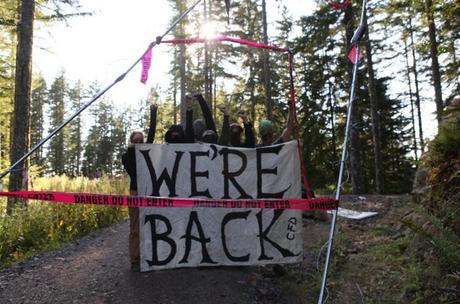
By Will Poter, Vice
Most people have heard of tree-sitting—a tactic environmentalists use to prevent old-growth trees from being cut down and whole forests decimated. In its heyday, in the late 1990s and early 2000s, members of groups like Earth First! climbed 100-foot-tall Redwoods and stayed there to save them. Beginning in 1997, one woman in Humboldt, California, named her tree Luna and stayed in it for two years, until enough money could be raised to prevent it from being axed. In 1998, in a Northern California old-growth forest, another treesitter named David “Gypsy” Chain was “accidentally” killed when loggers felled a tree that came crashing into the protester. He died instantly of massive head trauma.
This style of protest was also hugely successful—that is, until a series of arrests in 2005 against radical environmentalists who were labeled “terrorists.” It scared the shit out of the environmental-activist community, and folks started drifting away.
Now, there’s a vibrant national protest movement reviving those “direct action” tactics of civil disobedience again, and adding a new political savvy to the mix. They, too, have been incredibly effective. In Oregon, in the summer of 2011, one blockade took 50 cops, a backhoe, and a 125-foot-crane to remove treesitters. A few days later, activists locked themselves together in an Oregon Department of Forestry office. The group responsible, the Cascadia Forest Defenders, say they won’t stop until the Elliott State Forest is protected from clearcutting.
As a result—surprise, surprise—politicians are trying to create new laws that make tree-sits and other direct-action techniques illegal. The bills even single out the Elliott State Forest campaign by name and allow corporations to sue protesters for costing them money.
On April 29, two bills passed the Oregon House that would hit tree sitters and non-violent protesters with felonies and mandatory minimum sentences.
“There’s been a 30-year reign of terror by these people having no respect for the rights of others,” says Rep. Wayne Krieger, a Republican. Krieger says “environmental terrorists” have been “chaining themselves to trees, locking themselves to equipment, and laying down in the road.”
Krieger, a tree farmer and former member of the Oregon Board of Forestry, has introduced HB 2595. It would create a new crime of “interference with state forestland management.” The first offense, a felony, carries a mandatory minimum sentence of 13 months; another offense kicks that up to a $25,000 fine and five years in prison. That’s five years for non-violent civil disobedience.
A companion bill, HB 2596, allows loggers to sue protesters for up to $10,000 in lost income up to six years after a protest ended.
Who are the environmentalists responsible for this terror?
“I coach kindergarten soccer,” says Jason Gonzales of Cascadia Forest Defenders. He testified against the bill and questioned lawmakers’ priorities. “We have students, we are professionals, we meet with governors, we present at panels. And when it’s the last resort we put our bodies on the line.”
Supporters of the bills say they are needed to combat protests against increased logging on federal lands, specifically the tree-sits in the Elliott State Forest. In the absence of real protective measures from the Obama administration or state lawmakers, protests have been escalating. Obama signed off on logging in the Alaskan rainforest (a move later blocked by a federal district court), and activists say his new national forest proposal lacks any real teeth.
“It clearly is targeting speech,” says Becky Strauss, who is legislative director of the ACLU of Oregon. The bills place a heightened penalty on protest because of what is being protested. “It leaves it open to a police officer’s unbridled discretion as to when and how to enforce this bill, and we expect this to be enforced disproportionately based on the content of their speech.”
Sound unconstitutional? The courts thought so, too. Oregon once had a nearly identical law that criminalized “interference with agricultural operations.” It was struck down in 2009 as unconstitutional because it outlawed environmental protest but made an exception for labor protest.
Lauren Regan, an attorney with the Civil Liberties Defense Center, led the fight against that bill. She says these new bills are zombified versions of the dead laws, and if they pass they’ll be challenged in court. Again.
But dead legislation isn’t the only thing being resurrected. The direct action wing of the environmental movement has been increasing in intensity in the last few years. In protests against the Keystone XL pipeline, activists in Texas have been locking themselves to bulldozers and climbing onto tripods. In Oklahoma, two people were just arrested for chaining themselves to heavy equipment.
If these effective tactics continue, activists fear the Pacific Northwest won’t be the only states considering new laws against protesters. In many ways, these bills against environmentalists are similar to “ag-gag” laws against animal rights activists that are being considered around the country; just as the ag industry is trying to create a crime of “animal agriculture interference,” the forest industry is trying to create a crime of “interference with forestland management.”
Corporations should be worked about much more than “interference,” Jason Gonzales says. “Creating a mandatory minimum prison sentence won’t stop us from fighting these projects but it will change the way we have to fight them,” he says. “My very genuine concern is that it will force large sections of our movement to take their actions further underground. Indeed, instead of stopping us, it may encourage us to accomplish more when risking so much.”
Will Potter is the author of Green Is the New Red: An Insider’s Account of a Social Movement Under Siege.
Follow Will on Twitter: @will_potter

